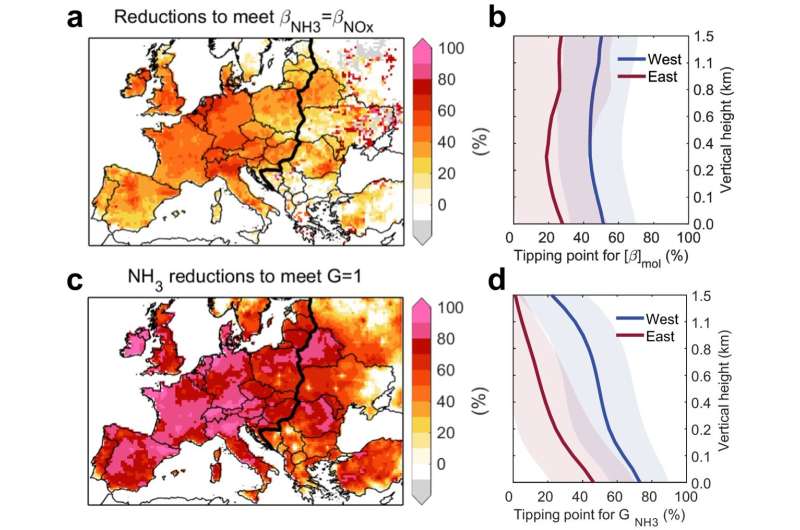This article has been reviewed according to Science X's editorial process and policies. Editors have highlighted the following attributes while ensuring the content's credibility:
fact-checked
peer-reviewed publication
trusted source
proofread
Ammonia reduction should be prioritized in Europe's fight against air pollution, says study

Europe still faces numerous challenges in reducing air pollution. A new study by an international team of researchers identified the reduction of ammonia emissions as a cost-effective measure to reduce concentrations of fine particulate matter concentrations in the atmosphere.
Pollution particles of less than 2.5 micrometers in diameter in the air around us, also known as fine particles or PM2.5, is one of the leading environmental risk factors for premature deaths worldwide, including in Europe. Despite successful reductions in the emissions of air pollutants such as sulfur dioxide, particulate matter, and nitrogen oxides, the new World Health Organization (WHO) air quality guidelines are still exceeded in many parts of the continent.
According to the authors of the new study just published in Nature Communications, phasing out emissions of ammonia and nitrogen oxides could reduce concentrations of PM2.5 by 2.3 µg/m3 over Europe on annual average and avoid about 100,000 premature deaths each year.
When it comes to reducing pollution, cutting down on nitrogen oxide has a steady impact. However, reducing ammonia is not as effective at first, but it becomes crucial when aiming for significant pollution reduction. Moreover, abating ammonia emissions is about five to ten times as cost-efficient for the same reduction in PM2.5 making it clear that a focus on ammonia reductions will be vital to achieve deep cuts in pollution over all of Europe.
"We were able to identify different chemical regimes in our modeling approach. The effects originally differ in different parts of Europe as the initial chemical composition of the atmosphere varies," explains Zehui Liu, lead author of the study and a researcher at the Laboratory for Climate and Ocean-Atmosphere Studies at Peking University in China. "We see the same effect when abatement kicks in successfully—once nitrogen oxide reductions are in place, it becomes increasingly more important to remove ammonia."
The authors agree that their results will help establish policy priorities. "Most nitrogen oxide emissions come from factories and vehicles, and we've already taken steps to control them. However, when it comes to agriculture, which is the main source of ammonia emissions, we haven't made much progress. This means there's an opportunity to achieve positive results by implementing effective measures in the agricultural sector," notes Wilfried Winiwarter, a study co-author and senior research scholar in the IIASA Pollution Management Research Group.
"We found that air quality improvements differ from one region to another. Additionally, achieving further improvements in air quality levels for particulate matter would also demand stricter control measures for pollutants other than nitrogen oxides and ammonia," adds Harald Rieder, another study co-author and Professor at the University of Natural Resources and Life Sciences (BOKU) Vienna.
"We can also learn for other parts of the world, such as China and India. Having successfully initiated air pollution reductions in China, we now need to determine the next steps of emission reductions," concludes study co-author Lin Zhang, a Professor at Peking University.
More information: Zehui Liu et al, Optimal reactive nitrogen control pathways identified for cost-effective PM2.5 mitigation in Europe, Nature Communications (2023). DOI: 10.1038/s41467-023-39900-9
Journal information: Nature Communications





















